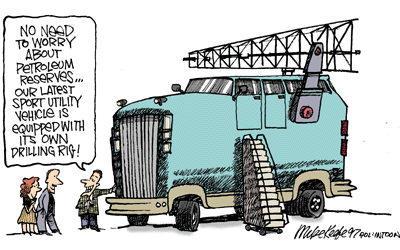- Sustainable Transport -- land, water, air, space
- SolarEvolution™ -- Tools for Mobility in a World Beyond Oil
- Solar-powered Personal Rapid Transit ("PRT")
Coming soon to auto row in your home town!

Replacing the now extinct ...

| Links |
|---|
|
|
See the all new DonCar Sports Utility Vehicle Coming soon to auto row in your home town!  Replacing the now extinct ...  |
Greenhouse gas emissions from transport remain a key, but avoidable, obstacle to the EU reaching its Kyoto climate change targets, according to a new European Environment Agency (EEA) report, released in Copenhagen today...Between €270 and €290 billion is spent annually in Europe in transport subsidies. Almost half of these subsidies go to road transport, one of the least environmentally friendly modes.
 Swiss boat claims first solar Atlantic crossing [2007 February 4]
Swiss boat claims first solar Atlantic crossing [2007 February 4]
"A Swiss-made catamaran has become the first solar-powered boat to cross the Atlantic after reaching the French Caribbean island of Martinique.... It is claimed to be the first-ever motorized vessel to complete the journey without using any fuel."
 Consistently moving 4,000 lbs of metal to move 200 lbs of people is not efficient enough to survive peak oil.
Consistently moving 4,000 lbs of metal to move 200 lbs of people is not efficient enough to survive peak oil.
Solar Power Potential with PRT, by Ron Swenson, ATRA Santa Cruz [2006 November 18]
"Solar is sufficient to power high capacity Personal Rapid Transit [Podcars] -- 100 percent -- using only the system’s 4’ to 8’ right of way."
A Clean and Quiet Revolution, by Steve Heckeroth [2006 May]
"The technologies exist to clean the air, stabilize the climate and maintain our standard of living all at the same time. By relying on clean renewable technologies we can eliminate much of the US trade deficit and the reason for war while achieving energy independence."A quick study ... shows the overwhelming advantages of plug-in hybrid (PHEV) and battery electric vehicles (EV). EVs are zero emission and can be charged from zero emission renewable energy sources like the sun and wind. By adding more batteries to hybrid electric vehicles (HEV) plug-in hybrids (PHEV) can be built which offer the range of gas vehicles (400 Mi.) with the environmental benefits of electric vehicles for short trips."
How many air-miles are left in the world’s fuel tank? by John Busby [2005 June 29]
"In BP’s Statistical Review 2005, jet fuel consumption figures are obscured by being “rolled-up” in regional statistics for “middle distillates”, which include kerosene, jet fuel, diesel and fuel oils. To obtain a rough guide for global jet fuel consumption, the US airlines consumed 18.5 billion gallons in 2004 compared with the US middle distillates consumption of 6,087 thousand barrels per day in the same year. From this it can be derived that roughly 20% of the distillates production is civil aviation jet fuel."
Firm Outlines Plans for Urban Rail Project; Near the Trigger Point... Time to Act [2005 June 9]
"PRT in Kuwait"
PHEV 20 = over 60% GHG reduction, by CARB Staff [2004 August]
"Reduction in Greenhouse Gas Emissions from Selected Passenger Vehicles and Fuels (well-to-wheels analysis)"
The EV Business: A Post-Mandate Perspective, by Tom Gage, AC Propulsion, Inc. [2003 October 18]
The Energy Imperative: Energetics more than emissions must inform automobile design over the coming decades. Electricity must substitute for petroleum as an energy source for automobiles. Use less gas or fight more wars."

Three Key Developments for Surface Transportation
How to Win an Argument with a Car Driver.
A portent of things to come:
We had hoped to avoid any surcharge indefinitely, but we are now forced to implement a temporary 1.25% fuel surcharge on all Air, Ground and International packages tendered to UPS on or after August 7, 2000."
USA Transportation Statistics • 2005 • Statistics for G7 countries (pdf, 3 mb)
|
Why trains?
The larger the number, the greater the energy efficiency. For comparison, a two ton car would have to get 375 miles per gallon to equal the energy efficiency of a train. thanks to James A. Hellams for this chart |
Car | 25 to 50 gross ton miles per gallon |
| Airliner | 60 to 65 gross ton miles per gallon | |
| Bus | 110 to 120 gross ton miles per gallon | |
| Truck/18 wheeler | 120 to 200 gross ton miles per gallon | |
| Train | 750 gross ton miles per gallon |